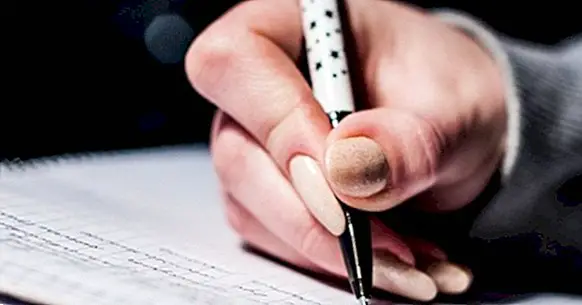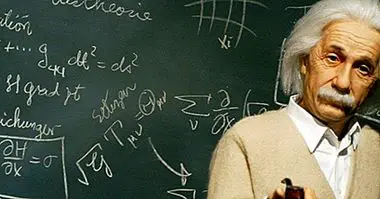Graphology and Personality: 5 main writing features
With the analysis of writing the graphologists try to know aspects of the personality that the analyzed person does not want to present to us , either because it is not convenient for him to do so, because he is not aware of them or simply because they seem irrelevant.
In addition, graphological analysis is also used to contrast the information obtained by other techniques, such as self-reports or a personal interview. The latter is common in personnel selection processes.
What can graphology provide us?
These techniques are currently used in Spain. In France its use is greater, it is estimated that between 50 and 75% of companies use it. In the year 1991 (date of the last independent study) 90% of French companies used directly or indirectly the information provided by the deed .
How is a writing analyzed?
To explain how the analysis of writing works, I always use the same example, Graphology is like putting together a puzzle .
If you look at a piece, most likely you do not know anything about it, or where it goes, or what is represented in it, you may also vaguely recognize something in that piece, to connect this piece with the four that correspond and you may appreciate something familiar, it is likely that with little poise but as you are connecting pieces your perception of the matter is going to adjust more to reality. You may notice a piece that is very characteristic, for example the eye of the tiger that is embodied in the puzzle, then you will know the meaning of that piece, and more or less where it will be located.
5 variables with interpretations shared by the vast majority of graphologists
Continuing with the metaphor of the puzzle, now I am going to write about some pieces in which the graphologists are fixed to obtain a meaning of them with little or no need to connect them with others.
Because, within all the scriptural variables from which interpretations are generated, there is a group of them whose associations with the corresponding personality traits to which they refer. They are generally stable signs that can be interpreted simply, however, graphologists contrast more data. That is to say, that in graphology these variables generate quite stable conclusions about the personality of the subject in the majority of cases.
1. Mix of lowercase and uppercase
This situation occurs when we see a text in which, predominantly, the lowercase letters are also present in capital letters (ignoring the necessary for correct spelling). Uppercase letters are interspersed with lower case letters.
This sign it has been related to the typology of the infidel cashier . It would be a sign of tendency to daily theft and disloyalty. However, the graphologists pay attention to the other variables presented in the text and contrast that there is no reasonable confrontation in aspects related to loyalty. That is, they check that the other variables in the text are not indicating otherwise. .
(Writing sample in which upper and lower case are mixed)
2. Mid-area overhang
What is super elevation? Quickly, that the text (for example, in a signature) is higher than wide. And the middle zone? All that area that is framed between the upper and lower limits of the oval of a writing, (eg, the letter -o-, the oval of the -d-, -g- or -p-) that is, encompasses the area in which all the letters that have no upper or lower projection (hampas or jambs respectively, in graphological jargon) are written.
In graphology, the overreaching of the middle zone is considered a negative sign in most cases, can suggest a certain arrogance in the personality, pride, extolling the self ... A proud person, proud, conceited and not very pleasant to treat because of the 'superior' that he feels, surely present this variable in the writing, in the signature or in both. I remember another golden rule of graphology: the fact that a sign is not present does not indicate connotations contrary to those presented if there were.
As examples, the signing of Himmler (powerful Nazi commander) and the signing of Donald Trump (candidate for the US presidency).
(The two firms on the left of D. Trump, both on the right of Himmler)
3. The filiformity
The filiformity refers to the type of writing that takes the form of thread. It is typical to see this in cartoons when a letter appears, normally they have not bothered to represent readable words and simply make a line with brief oscillations and separations resembling the course of a real writing.Filiformidad is to print a line (or almost a line) where there should be a shape, for example, is typical in the -m- or -n-, the mountains are dwindling until on occasion due to dynamism is simply drawn a line.
It is necessary to distinguish between general filiformity and partial filiformity. It can be a whole filiform word (general fil), it can be filiform only the end (very common) or certain combinations of letters (partial fil). In graphology, the general filiformity will have a more positive interpretation than the partial one, being the partial one related to the insincerity, lack of authenticity of the person or neurotic conflicts.
It is also mandatory to establish differences between the filiform writing executed with dynamism and high speed of the slow filiform, the first has positive connotations, it would be attributable, as a trend, to a person with good social skills, with negotiation skills, with good strategic sense or diplomatic skills On the slow filiform it is necessary that we realize, that we reproduce, that we think about how this type of writing has been executed. The filiformity is normal when the speed scriptural accelerates, is a trait indicative of speed, however, someone who is producing filiformidad at low speed is doing it deliberately, that subject is producing, with intention, a slow and illegible writing, in addition normally There is a situation in which who writes filiform has a high graphic culture with which the hypothesis of the lack of writing ability is generally discarded. Writ illegible ex profeso, in the words of Manuel J. Moreno: "[...] we can be faced with attitudes snobistas and inautenticidad"
The writing of the following image is of the politician Alfredo Pérez Rubalcaba , slow and extreme filiformity.
(Filiform script samples Alfredo Pérez Rubalcaba left, unknown samples on the right)
4. Dissociation
It is called dissociation to the graphic phenomenon by which the oval of the palote is separated. This can occur in letters such as -d-, -g- and -p-. It happens when the oval is executed on the one hand and on the other hand the handle, in this case we have dissociation in the writing. It is a very easy sign to notice, it hits the eye quite a lot, and even according to the pattern of spaces that that writing maintains, it can confuse us in the reading taking the oval for a -o- and the palote for a -L- (in the letter) -d-)
This sign, in the words of Manuel J. Moreno , and connecting with psychoanalytic theories, "could be symbolic externalization of a tendency to split or conflict between the self and the id (the unconscious)". For his part, Augusto Vels relates to the quality of the family relationship in childhood "[...] The mere fact of being separated both elements is an excellent sign of conflict or disagreement, a frequent sign in people who have lived a childhood with badly avenged [...] parents who have felt marginalized affectively "
(Dissociated writing sample "Dignity" and "Degraded")
(Dissociated writing sample Word "Córdoba")
5. The enveloping rubric
Entering terminology, the signature is the scribble when signing, the illegible, and the legible part signs, of course any combination between them can be found in the autograph of a person, there can be only a signature, only a rubric, both, etc ... he calls the surrounding rubric to the graphic design whose outline surrounds the signature. It's very common, surely you know someone who signs like that.
In graphology, it is associated with the pleasure of being cared for, the need to feel protected in the family or marriage . In a positive graphical environment it is related to prudence and caution. Mauricio Xandró, explains: "It corresponds to a movement of introversion and to the manifestation of a feeling of juvenile inferiority. [...] Almost unanimity of graphologists see a gesture of protection and isolation, which is also correct".
(Writing sample: enveloping rubric, signature "Pedro Jiménez")
Graphology is a complement, another technique of the repertoire
In the analysis and interpretation of scriptures there is a rule that is present from the first moment. If you ask a graphologist, it is likely that your question is similar to: "and ... What does it mean when I lean to the right?" or "What about those who sign with a scribble that never looks like one another?" and the most normal answer is to resolve the doubts presented, at least at first, but then the most likely thing that the professional you have asked will be to mention the need to contrast this particular fact that you have proposed with the other variables present in the writing for a correct and firm interpretation.
The need to contrast with the other variables comes from the differentiation between positive graphic environment and negative graphic environment , being able to have the same variable of the writing different interpretations according to the graphic environment in which it is.The graphical environment is determined by a series of aspects whose valuation must be done separately due to the extension.



















